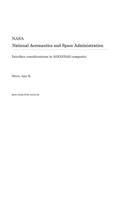
Interface Considerations in Al2o3/Nial Composite
Series:
The fiber-matrix interface requirements in an Al2O3/NiAl composite were examined from theoretical considerations. Several factors that influence the interface bonding requirements were analyzed. These include: (1) residual stresses due to fiber-matrix coefficient of thermal expansion (CTE) mismatch; (2) matrix cracking stress at room temperature; (3) fracture toughness at room temperature; (4) loa
NaN
VOLUME
English
Paperback

The fiber-matrix interface requirements in an Al2O3/NiAl composite were examined from theoretical considerations. Several factors that influence the interface bonding requirements were analyzed. These include: (1) residual stresses due to fiber-matrix coefficient of thermal expansion (CTE) mismatch; (2) matrix cracking stress at room temperature; (3) fracture toughness at room temperature; (4) load transfer from the matrix to the fiber and ultimate tensile strength at the use temperature; and (5) creep resistance at high temperature. A relatively weak fiber-matrix bond, with an interfacial shear strength of approximately 15-20 MPa, might be sufficient for attaining the desired mechanical properties in the fiber direction at the use temperature. A weak fiber-matrix bond is also beneficial for increasing the fracture toughness of the composite at room temperature. In contrast, a strong fiber-matrix bond is required to withstand some of the residual stresses resulting from the fiber-matrix CTE mismatch, which are not likely to be reduced significantly by interface coatings. A relatively strong bond is also beneficial in increasing the matrix cracking stress at room temperature. Various interface coating options to accommodate the conflicting bonding requirements were reviewed. One viable coating option is to incorporate a thick, ductile interface layer well bonded to both the fiber and the matrix. Misra, Ajay K. Unspecified Center NAS3-25266; RTOP 510-01-50...
Price Comparison [India]
In This Series
Bestseller Manga
Trending NEWS




















